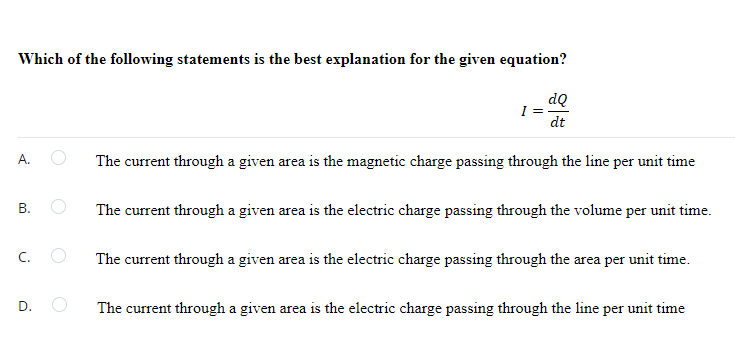1.Consider a situation where a balloon is rubbed on hair, the balloon is negatively charged. What charge does the hair have? A.Positive B.Neutral C.Negative D.No charge
1.Consider a situation where a balloon is rubbed on hair, the balloon is negatively charged. What charge does the hair have? A.Positive B.Neutral C.Negative D.No charge
Introductory Circuit Analysis (13th Edition)
13th Edition
ISBN:9780133923605
Author:Robert L. Boylestad
Publisher:Robert L. Boylestad
Chapter1: Introduction
Section: Chapter Questions
Problem 1P: Visit your local library (at school or home) and describe the extent to which it provides literature...
Related questions
Question
1.Consider a situation where a balloon is rubbed on hair, the balloon is negatively charged. What charge does the hair have?
A.Positive
B.Neutral
C.Negative
D.No charge
2.Gauss’s law states that
A.the outward flux density of D through a closed Gaussian surface, S is equal to the enclosed charge Qenc in that surface.
B.the inward flux density of D through a closed Gaussian surface S is equal to the enclosed charge Qenc in that surface.
C.the outward flux density of D through an open Gaussian surface, S is equal to the enclosed charge Qenc in that surface.
D.the outward flux density of D through a closed Gaussian surface S is not equal to the enclosed charge Qenc in that surface.

Transcribed Image Text:Which of the following statements is the best explanation for the given equation?
dQ
I =
dt
А.
The current through a given area is the magnetic charge passing through the line per unit time
В.
The current through a given area is the electric charge passing through the volume per unit time.
C.
The current through a given area is the electric charge passing through the area per unit time.
The current through a given area is the electric charge passing through the line per unit time
Expert Solution
This question has been solved!
Explore an expertly crafted, step-by-step solution for a thorough understanding of key concepts.
Step by step
Solved in 3 steps

Knowledge Booster
Learn more about
Need a deep-dive on the concept behind this application? Look no further. Learn more about this topic, electrical-engineering and related others by exploring similar questions and additional content below.Recommended textbooks for you

Introductory Circuit Analysis (13th Edition)
Electrical Engineering
ISBN:
9780133923605
Author:
Robert L. Boylestad
Publisher:
PEARSON

Delmar's Standard Textbook Of Electricity
Electrical Engineering
ISBN:
9781337900348
Author:
Stephen L. Herman
Publisher:
Cengage Learning

Programmable Logic Controllers
Electrical Engineering
ISBN:
9780073373843
Author:
Frank D. Petruzella
Publisher:
McGraw-Hill Education

Introductory Circuit Analysis (13th Edition)
Electrical Engineering
ISBN:
9780133923605
Author:
Robert L. Boylestad
Publisher:
PEARSON

Delmar's Standard Textbook Of Electricity
Electrical Engineering
ISBN:
9781337900348
Author:
Stephen L. Herman
Publisher:
Cengage Learning

Programmable Logic Controllers
Electrical Engineering
ISBN:
9780073373843
Author:
Frank D. Petruzella
Publisher:
McGraw-Hill Education

Fundamentals of Electric Circuits
Electrical Engineering
ISBN:
9780078028229
Author:
Charles K Alexander, Matthew Sadiku
Publisher:
McGraw-Hill Education

Electric Circuits. (11th Edition)
Electrical Engineering
ISBN:
9780134746968
Author:
James W. Nilsson, Susan Riedel
Publisher:
PEARSON

Engineering Electromagnetics
Electrical Engineering
ISBN:
9780078028151
Author:
Hayt, William H. (william Hart), Jr, BUCK, John A.
Publisher:
Mcgraw-hill Education,